Column: A true story about transit in Monroe County—it’s not about a change in the map
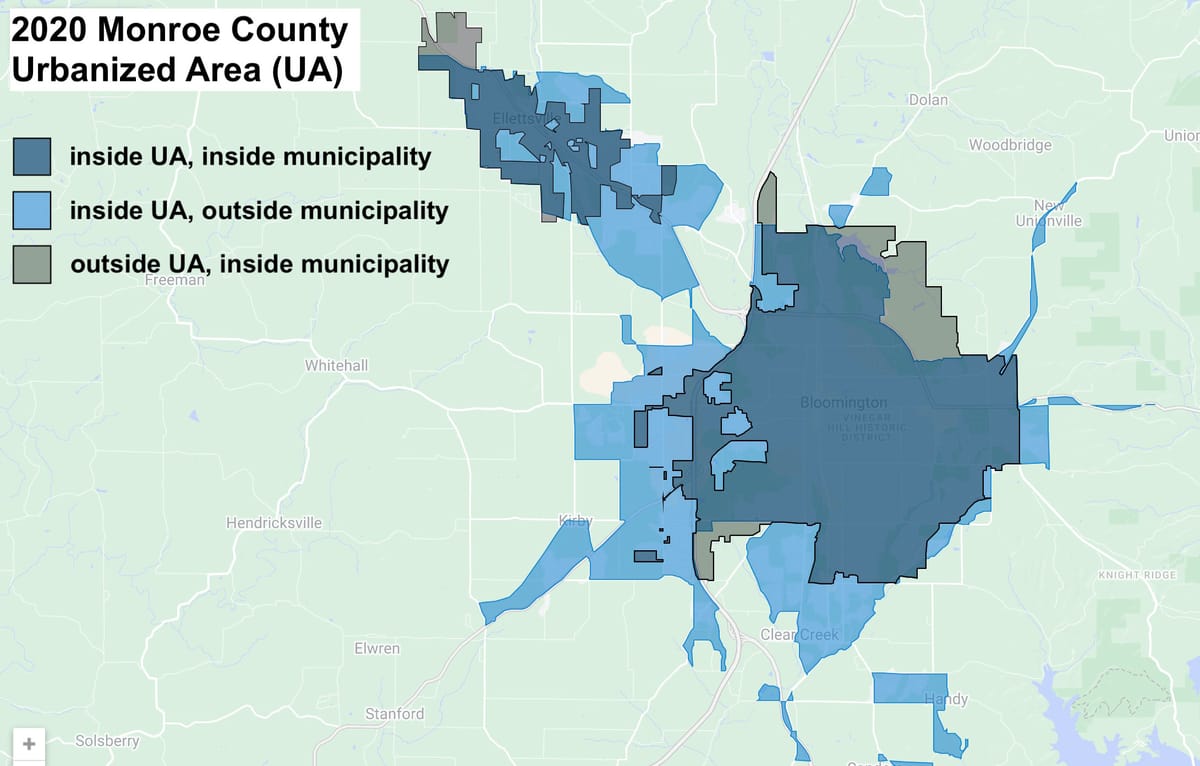
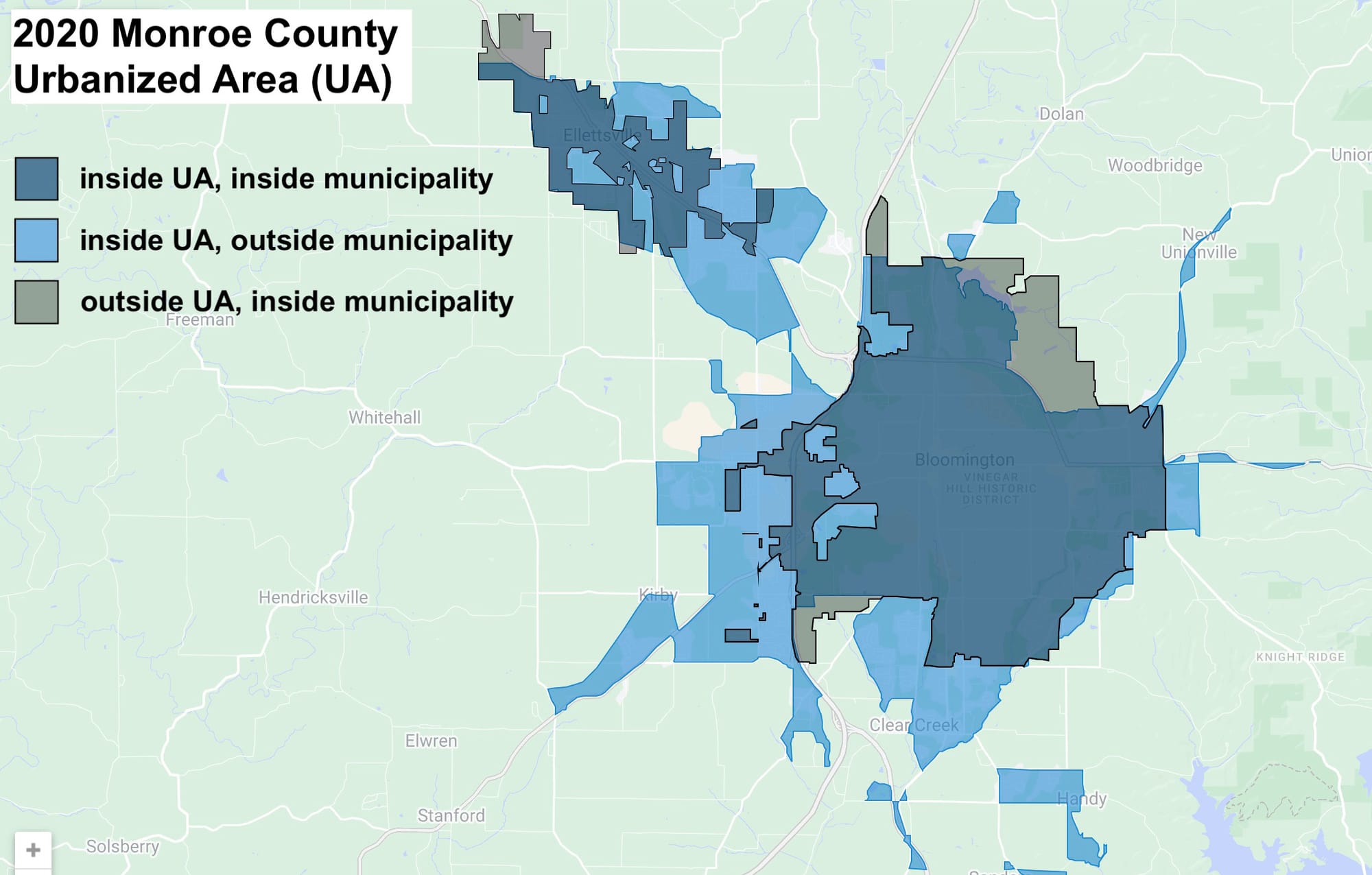
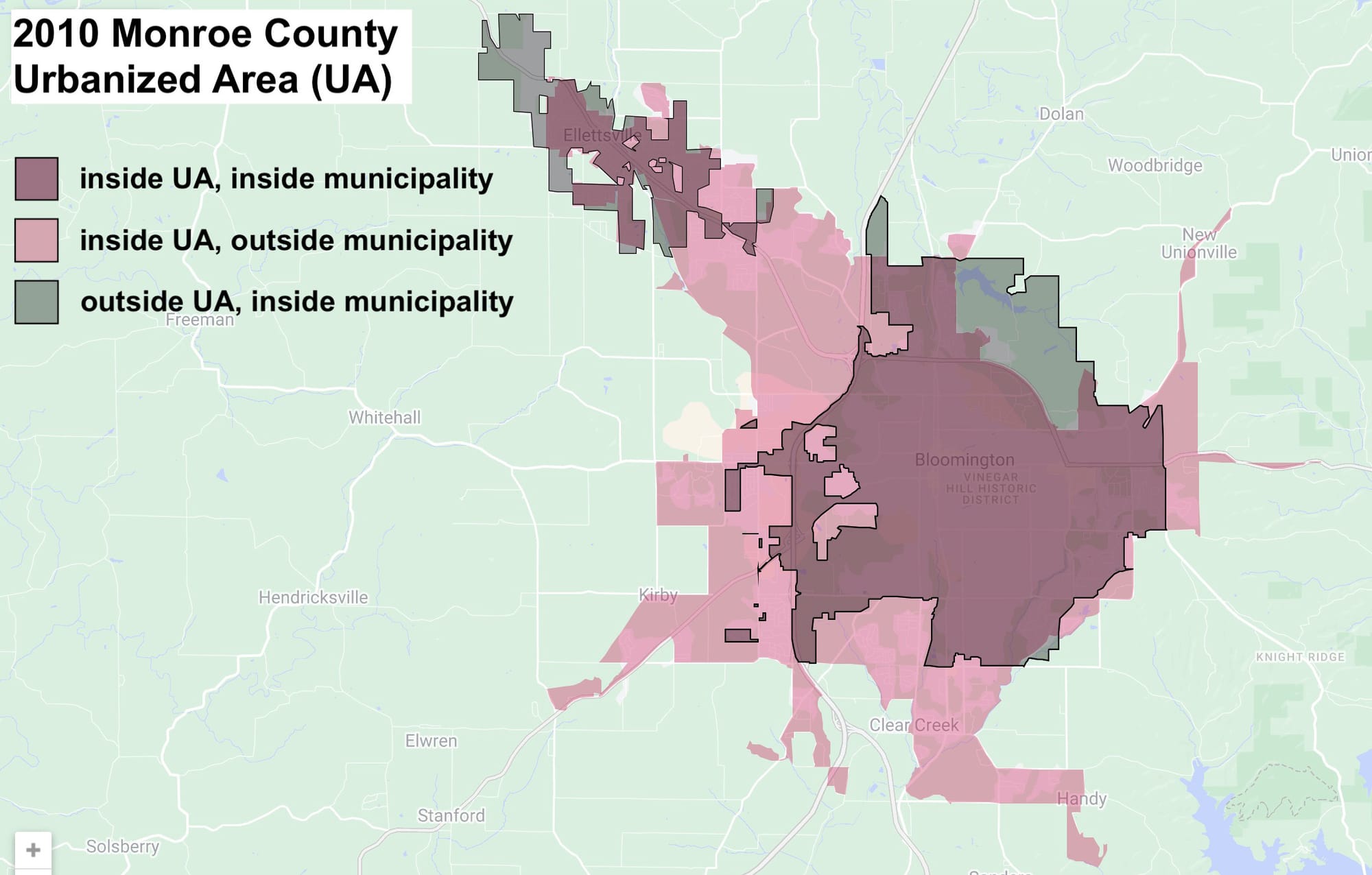
Stories about public transportation can be fun. But only if they’re true.
This past Wednesday afternoon, Bloomington Transit, the city’s public bus system, convened a “transit summit” at the Monroe Convention Center.
It was attended by around 60 people, which included elected and appointed officials, as well as staff from a few different governmental units.
Wednesday’s three-hour meeting was planned by representatives from Foursquare ITP, which is Bloomington’s hired consultant for its recently adopted strategic plan.
Objectively measured, the breakout groups generated a lot of useful ideas about unmet transportation needs, and ways that transit providers could meet them.
But the final hour of the meeting—which was designed for elected officials and decision makers—was marred by an untrue story, told by Foursquare.
Part of the story is true: Transportation services are now somewhat in jeopardy for those Monroe County residents who live outside Bloomington city limits but inside the “urbanized area” (UA) as defined by the U.S. Census Bureau. There’s a funding crisis for those trips.
The part that was not true involves the cause of the funding crisis.
It’s important to hold Foursquare accountable for its mistake. It is vital for local decision makers to accurately understand the origin of the crisis in order to have a chance at achieving an equitable and sustainable solution.
A difference in maps?
Foursquare portrayed the funding crisis as stemming from a change in the official UA map—between 2010 and 2020.
Maps for urban areas are generated by the Census Bureau every 10 years. An urban area is defined in terms of population numbers, density and land use. Generally, an urban area can include more area than just the political boundaries of a city.
First, the map did change, but not in the way that Foursquare described it at Wednesday’s meeting. According to Foursquare, before the UA map was revised in 2020, “the area in and around Ellettsville was not part of the urbanized area.” A side-by-side comparison of the UA maps for each year shows that to be untrue.

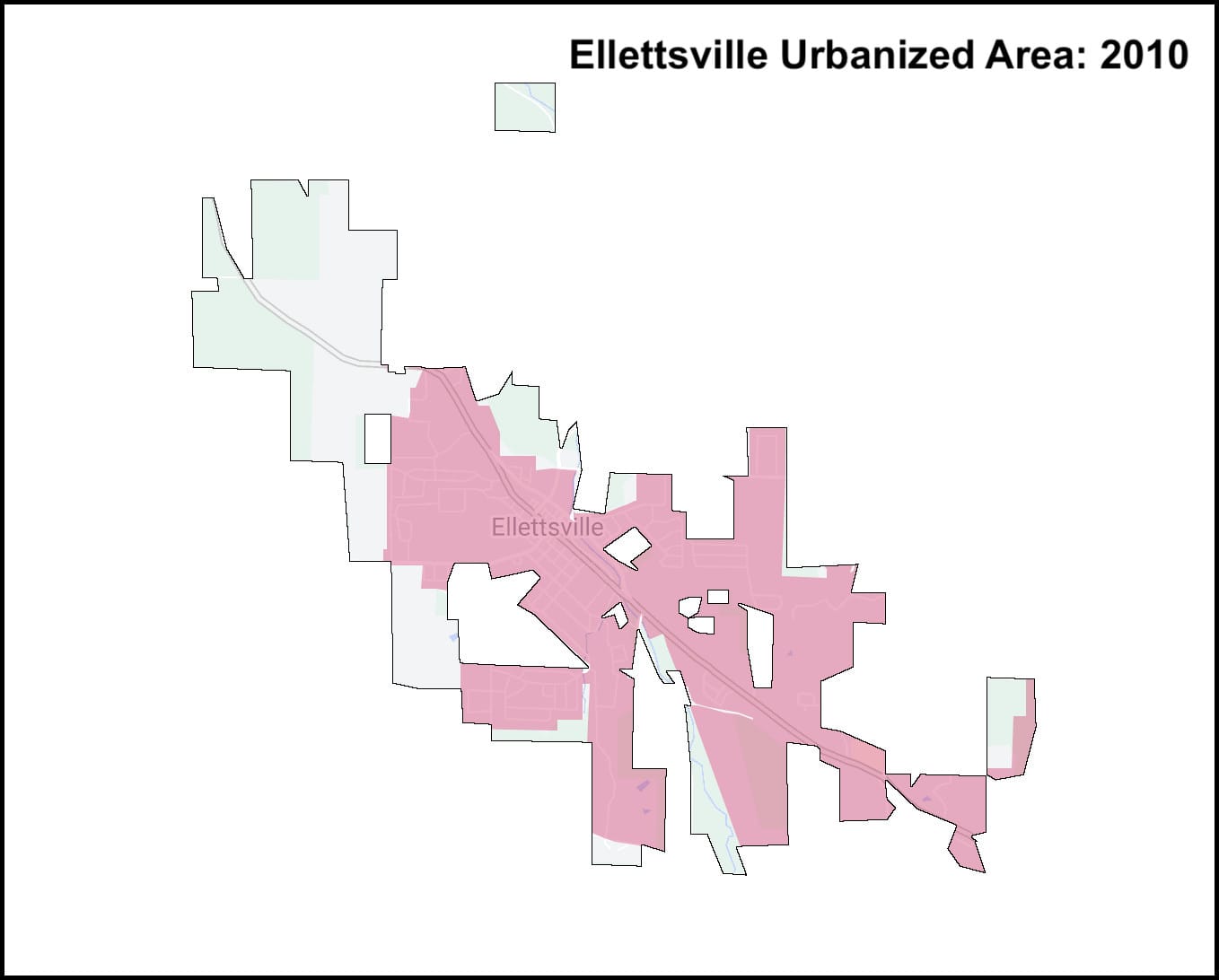
A factual characterization of the difference in maps would be: Most of Ellettsville was already a part of the UA in 2010—but the 2020 UA map revision classified even more of Ellettsville as part of the UA.
But fretting over the precise characterization of map changes is a distraction. That’s because the actual cause for the funding crisis has nothing to do with any change in the UA map. The cause of the funding crisis is a change to the way an existing federal transit funding rule is enforced—a change that started in 2024.
A change to 5011 funding enforcement
The change to enforcement basically entails following the letter of the rule, instead of a practical approximation to the rule. Historically, it’s the practical approximation that allowed Rural Transit, which is an agency of Area 10 on Aging, to provide certain trips outside Bloomington city limits, but still inside the urbanized area.
The rule applies to funds received by Rural Transit through the Section 5311 FTA (Federal Transit Administration) non-urbanized area formula grant program. The money is passed through from the feds to Rural Transit by INDOT (Indiana Department of Transportation).
Historically, Rural Transit provided trips only between points where at least one of the two locations were outside Bloomington. That includes trips where both points were outside Bloomington. If both the origin and destination were inside the city of Bloomington, that’s not a trip that Rural Transit historically provided.
Rural Transit’s historical trip policy only approximated the INDOT guidance for receiving Section 5311 funding. That’s because INDOT’s manual does not define possible trips in terms of political boundaries, like Bloomington’s city limits. Instead, it uses “urban areas” as defined by the US Census Bureau.
Here’s how the 2016 INDOT manual on Section 5311 funding sets out the policy against making a trip where an urban area includes both the origin and the destination (emphasis added in bold):
Service may include transportation to and from urbanized areas. However, such services should not include both pick-up and discharge operations within the urbanized area, particularly if the urbanized area is served by public transit.
A common way to refer to the trips that cannot be funded by 5311 money is to call them urban-to-urban trips.
An example of an urban-to-urban service that Rural Transit provided historically, but no longer can—if it uses 5311 funds—is an Ellettsville-to-Walmart trip. Historically that was allowed, because neither location is inside Bloomington. But most of Ellettsville is a part of Monroe County’s urbanized area. So is Walmart, on Bloomington’s westside. That makes it an urban-to-urban trip that can’t tap 5311 money for its funding.
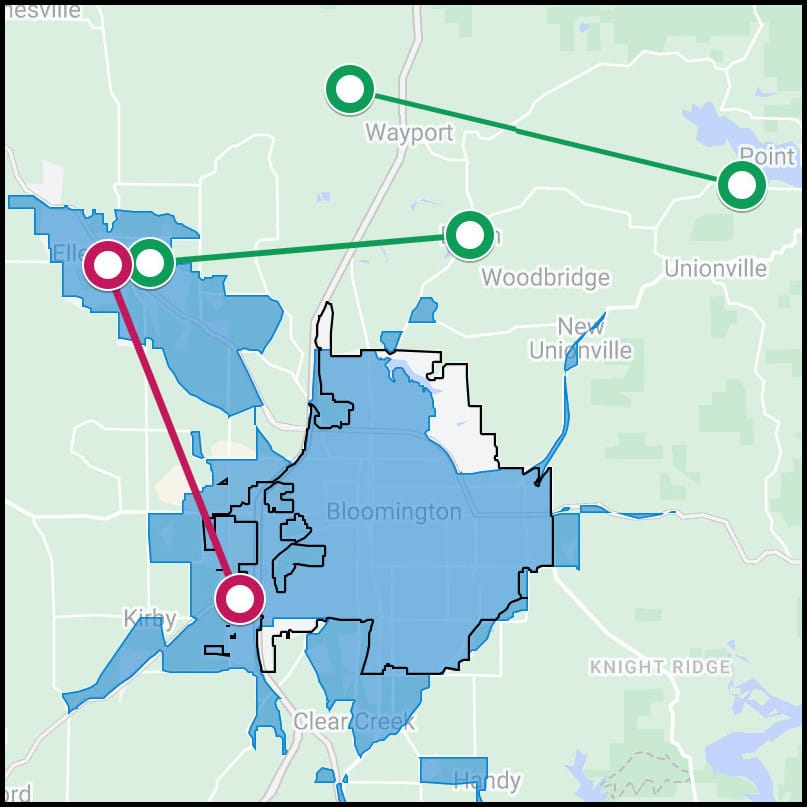
Historical non-enforcement of the 5011 rule
Why was the rule’s looser interpretation—which used Bloomington city boundaries instead of urbanized area boundaries—a reasonable practical alternative? A hint to the answer can be found in the same paragraph from the INDOT manual as before, with a different part emphasized:
Service may include transportation to and from urbanized areas. However, such services should not include both pick-up and discharge operations within the urbanized area, particularly if the urbanized area is served by public transit.
The condition in the bolded if-clause is not entirely satisfied for Monroe County, so the extra admonition in INDOT’s manual against using 5011 funds for urban-to-urban trips does not apply. That’s because Bloomington Transit has historically not served any of Monroe County’s urbanized area that is outside the city of Bloomington’s boundaries.
In fact, Bloomington Transit was not allowed, under local law, to serve that portion of the urbanized area outside city limits, until the city council, in August of 2023, finally passed an ordinance allowing countywide service by BT.
Without the change in the enforcement of 5311 funding restrictions, there would be no funding crisis—even though the urban area maps changed between 2010 and 2020.
Who should pay and how much?
With a clear understanding that it’s not a change in the map, but a change in the enforcement of the funding rule, it is easier to focus on the key question:
Whose responsibility is it now to provide and pay for urban-to-urban transportation service that’s outside of the city of Bloomington?
Whoever provides the service, federal 5311 funding can’t be used to pay for it.
Is there some other federal funding source that could be used to provide urban-to-urban service? Yes.
It comes through a different federal formula grant program—the Section 5307 formula program. Bloomington Transit is awarded 5307 funds every year.
The amount of money awarded through the 5307 program is based on population—of the urbanized area, not the city of Bloomington. The idea is that the feds want the recipients of 5307 funding, like Bloomington Transit, to serve the transit needs of all residents in the urbanized area.
But historically Bloomington Transit has not been providing any urban-to-urban trips outside the city of Bloomington—despite the fact that BT has received some funding, based on the idea that it should. That’s not to lay blame on Bloomington Transit. Until the city council’s passage of the August 2023 ordinance, BT could not legally provide such service.
One way to analyze the historical situation was that Rural Transit used its 5311 funding to cover the urban-to-urban trips that Bloomington Transit could not. The new 5311 enforcement regime, starting in 2024, means that Rural Transit can’t use 5311 money to provide the service. But the change to local law means that BT could now provide the service—in part by tapping the 5307 money that it has been historically receiving for that purpose.
How much annual revenue do residents of Monroe County’s urbanized area outside of Bloomington generate for BT? That’s the question that Monroe County councilor Geoff McKim asked at Wednesday’s transit summit.
The answer came from BT general manager John Connell. In 2022, BT received $4.1 million in 5307 federal funds, and of that, 28 percent was generated by residents outside the city of Bloomington. The arithmetic on that works out to $1.15 million generated by non-city residents—which was used to pay for transit service only inside the city of Bloomington.
An equitable basis for negotiations
Late last year, BT negotiated with the Monroe County government, and the town of Ellettsville, on the price that those two local governments should pay BT to provide the urban-to-urban trips outside the city of Bloomington. BT’s lowest offer was to charge $39 per trip, which worked to $312,000 for 8,000 trips. That price tag was based on the actual cost to BT to provide the service.
BT made three other higher-priced proposals, based on what it called “funding philosophies” One of the other proposals considers (as a percentage) the amount of revenue that the city of Bloomington now contributes annually to BT from the new economic development local income tax (ED LIT). The math on that is $3,806,100 out of $16,587,406. That’s about 23 percent of Bloomington’s ED LIT revenue.
Applying that same percentage to the ED LIT revenue for Monroe County government and the town of Ellettsville would mean a $2.9 million annual contribution to BT from those two governmental units, in order to provide the 8,000 trips.
It hardly seems like a good-faith offer to contemplate $2.9 million as a possible price tag for trips that have an actual cost of $312,000.
Instead of doing a deal with Bloomington Transit, Monroe County government and Ellettsville reached an agreement with Rural Transit on a one-year stop-gap measure that will pay Rural Transit $220,000.
Key to that arrangement is that Rural Transit is not supposed to use any 5311 money to pay for the urban-to-urban trips. That will be accomplished in part by using buses purchased with American Rescue Plan Act (ARPA) money.
In the future, when it comes to negotiating how much Bloomington Transit should receive from other governmental units, to pay for urban-to-urban service outside the city limits, an obvious ceiling would be the actual cost to BT of providing the service.
From that ceiling, the price should be negotiated downward, to reflect the fact that the residents of the area to be served already help generate some of the revenue to pay for the cost of BT’s service—through the 5307 funds, which are population based.
The percentage of the actual cost to be paid to BT should be in the spirit of the typical local funding match requirement for federal transit funds. For operating costs, the required local match for 5307 funds is 50 percent.
It’s possible to imagine an argument that other local units should pay BT more than 50 percent, in order to cover the administrative cost of federal grant administration.
This kind of thinking could provide a path to an equitable negotiation.
Focusing on the right factors for an equitable negotiation is way easier, when the parties to the negotiation have an accurate understanding of what caused the funding crisis.
Conclusion
The true story is that the funding crisis for urban-to-urban trips outside Bloomington was caused by a change to enforcement of a federal transit rule.
A story that blames the crisis on a change to the urban area map just isn’t true.




Comments ()